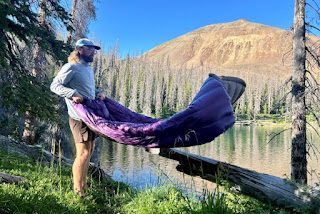When planning a camping trip, a good night’s sleep is crucial to fully enjoy the adventure. Choosing the right camping sleeping bag is essential for comfort, and warmth, ensuring you’re well-rested and ready for each day. With so many options to choose from, knowing what to look for can make all the difference.
Key Factors to Consider
Selecting durable camping sleeping bags goes beyond choosing one that looks cosy. From temperature ratings to fill types and shapes, each feature serves a specific purpose.
Temperature Rating
The temperature rating of a sleeping bag is a crucial factor to consider. It indicates the lowest temperature in the sleeping bag can keep you warm. When choosing a sleeping bag, select one with a temperature rating that is suitable for the conditions you'll be camping in. For warm-weather camping, you’ll need a sleeping bag with a higher temperature rating, while colder conditions call for a bag rated for lower temperatures. If you’re unsure about the climate, erring on the side of warmth or choosing a three-season bag is often a safe choice.
Fill Type
The sleeping bag’s insulation or “fill” highly influences its warmth, weight, and how well it packs. The two primary types are down and synthetic. Down-filled sleeping bags, known for their exceptional warmth-to-weight ratio, are lightweight and compressible, making them ideal for backpacking. However, they’re generally more expensive and lose insulation when wet, which may be a drawback in damp conditions. Some down bags are treated to be water-resistant, adding versatility but increasing the cost.
Synthetic-filled sleeping bags use man-made fibres that tend to be more affordable and are often water-resistant. They are also quicker to dry, making them a good option for wet or unpredictable climates. Although they tend to be bulkier than down, synthetic bags can still offer reliable warmth and comfort.
Shape
Sleeping bags come in various shapes, each designed for different levels of comfort and warmth retention.
- Mummy Shape: A mummy-shaped sleeping bag tapers from the shoulders to the feet, minimising airspace and retaining heat. This style is excellent for cold-weather camping as it provides maximum insulation. The snug fit may feel restrictive for some, but it’s perfect for those prioritising warmth.
- Rectangular Shape: For those who prefer a greater fit, rectangular bags provide extra space and versatility. Although they don’t retain heat as well as mummy bags, rectangular bags are comfortable and often a good choice for mild-weather camping.
Size
Ensure your sleeping bag fits your body size properly to get the most comfort and warmth. If the bag is too small, you may feel cramped, while an oversized bag can lead to heat loss. Many brands offer sleeping bags in multiple lengths to accommodate different heights.
Weight and Packability
Weight and packability are vital considerations if planning to hike or backpack. Down-filled bags are generally lighter and compress smaller than synthetic ones, making them ideal for backpacking. If you’re car camping, weight may not be a concern, so you might prioritise a roomier, synthetic option that’s easier to clean and maintain.
Choosing a Sleeping Bag for Different Weather Conditions
Warm Weather
A lightweight and breathable sleeping bag is ideal for warm-weather camping. Look for a low-temperature rating sleeping bag with a breathable fabric, such as cotton or synthetic materials. Prioritise comfort and ventilation to prevent overheating.
Cold Weather
Warmth and insulation are essential in cold weather conditions. Opt for a sleeping bag with a high-temperature rating and a thick, insulating fill, such as down or synthetic fill. A mummy-shaped sleeping bag can also help to trap heat and keep you warm.
Three-Season Sleeping Bags
Three-season sleeping bags are versatile and suitable for a wide range of temperatures. They offer a good balance of warmth and breathability, making them ideal for most camping trips. Consider a sleeping bag with a temperature rating that covers the range of temperatures you'll encounter on your trips.
Additional Tips
Consider Your Sleeping Habits
When choosing a sleeping bag, it's important to consider your personal sleeping habits. If you tend to sleep hot, opt for a lightweight and breathable sleeping bag. If you tend to sleep cold, choose a warmer sleeping bag with a higher temperature rating.
Check for Features
Look for additional features that enhance your comfort and warmth, like a hood, draft collar, and zipper baffles. A hood can help keep your head warm, while a draft collar can prevent heat loss around your neck. Zipper baffles can help to reduce drafts and keep you warm.
Read Reviews and Recommendations
Before purchasing a sleeping bag, read reviews and recommendations from other campers. This can help you to identify the right camping sleeping bags for your needs and budget.
Sleep Soundly Under the Stars
Choosing the right sleeping bag for camping is more than a simple decision - it’s an investment in a good night’s sleep. A well-chosen sleeping bag can provide warmth, comfort, and peace of mind, ensuring wake up refreshed and ready for the day’s adventures. When browsing sleeping bags for sale, consider key factors like temperature rating, fill type, shape, size, and weight to match your camping needs. Opting for a camping sleeping bag that caters to your unique preferences and camping conditions can improve the quality of your sleep and overall camping experience.


